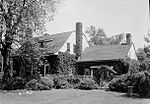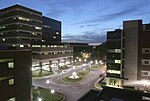The Maywood Public Schools are a comprehensive community public school district that serves students in pre-kindergarten through eighth grade from the Borough of Maywood, in Bergen County, in the U.S. state of New Jersey.As of the 2021–22 school year, the district, comprised of two schools, had an enrollment of 934 students and 82.0 classroom teachers (on an FTE basis), for a student–teacher ratio of 11.4:1.The district is classified by the New Jersey Department of Education as being in District Factor Group "FG", the fourth-highest of eight groupings. District Factor Groups organize districts statewide to allow comparison by common socioeconomic characteristics of the local districts. From lowest socioeconomic status to highest, the categories are A, B, CD, DE, FG, GH, I and J.After graduating from Maywood Avenue School, approximately 250 students in public school for ninth through twelfth grades had attended Hackensack High School in Hackensack, as part of a sending/receiving relationship with the Hackensack Public Schools, together with students from Rochelle Park and South Hackensack. In the wake of rising tuition costs assessed by the Hackensack district, the district has considered a plan under which the relationship with Hackensack would be severed and a new sending relationship would be established with other neighboring districts. In March 2020, the district received approval from the New Jersey Department of Education to end the relationship it had with Hackensack started transitioning incoming ninth graders to Henry P. Becton Regional High School, which serves students from Carlstadt and East Rutherford beginning in the 2020–21 school year. The transition would be complete after the final group of twelfth graders graduates from Hackensack High School at the end of the 2023–24 school year. Maywood cited costs of nearly $14,800 per student in 2018 to send high-school students to Hackensack and an annual cost in excess of $15,000 under a proposed new three-year agreement, while Becton would start at a per-pupil cost of $10,500 in 2020–21 as part of a ten-year deal that would have a maximum cost per Maywood student of $11,800 in the final year of the agreement. As of the 2021–22 school year, the high school had an enrollment of 653 students and 51.1 classroom teachers (on an FTE basis), for a student–teacher ratio of 12.8:1.





